![Best Concealed Carry Guns In 2025 [Field Tested] Best Concealed Carry Guns In 2025 [Field Tested]](https://gundigest.com/wp-content/uploads/Wilson-Combat-EDC-X9S-1-768x496.jpg)
We shot and carried a ton of concealed carry guns. Here are the handguns we find fit to cover your six.
Finding a handgun you can confidently use and comfortably carry every day is crucial. With countless options available, navigating through the various sizes, styles, calibers, and price points can be overwhelming. That's where I come in—to guide you through some of the top choices for concealed carry guns currently on the market.
How I Chose The Best Concealed Carry Guns
I’ll start by saying that selecting these concealed carry guns was a team effort. Each of these guns was shot, tested and carried by myself, Gun Digest staff or long-term and trusted freelancers. This avoids myopia, a one-person perspective on each of the firearms, and allows us to take into account different body types and backgrounds to give these guns a square day in court. Our experience ranges from certified handgun instructors to law enforcement and military. Oh yeah, there’s a master gunsmith in the mix too. Of all the pistols and revolvers carried, these were the ones that proved head and shoulders above the rest in the concealed-carry market when it came to reliability, comfort and accuracy.
2025 Best Concealed Carry Guns
- Overall Pick: Sig P365
- Runner-Up: Springfield Hellcat
- Best High-end Carry: Wilson Combat EDC X9
- Best Classic Carry: Glock 19
- Best Budget: PSA Dagger
- Best Carry Revolver: Ruger LCR in .327 Federal Magnum
- Best .357 Magnum: Ruger LCRx 3-Inch
- Best .380 ACP: Ruger LCP MAX
- Best Easy To Manipulate: Smith & Wesson Equalizer
- Best Backwoods Carry: Glock 20
Best Concealed Carry Guns Comparison
| Model | Caliber | Capacity | Barrel Length (in) | Overall Length (in) | Overall Height (in) | Overall Width (in) | Weight (oz) | MSRP |
|---|---|---|---|---|---|---|---|---|
| Sig Sauer P365 | 9mm | 10+1 | 3.1 | 3.1 | 4.3 | 1.1 | 17.8 | $600 |
| Springfield Hellcat | 9mm | 10+1, 13+1 | 3 | 3 | 4 | 1 | 18.3 | $600 |
| Wilson Combat EDC X9 | 9mm | 15+1, 18+1 | 4 | 7.4 | 5.25 | 1.4 | 29.09 | $3,210 |
| Glock 19 | 9mm | 15+1 | 4.02 | 7.36 | 5.04 | 1 | 21.16 | $600 |
| PSA Dagger Micro | 9mm | 15+1 | 3.41 | 6.5 | 4.7 | 1.1 | 15.9 | $300 |
| Ruger LCR | .327 Federal Magnum | 6 | 1.87 | 6.5 | 4.5 | 1.28 | 17 | $859 |
| Ruger LCRx | .357 Magnum | 5 | 3 | 7.5 | 5.8 | 1.28 | 17.3 | $859 |
| Ruger LCP Max | .380 ACP | 10+1 | 2.8 | 5.17 | 3.6 | .82 | 10.6 | $479 |
| Smith & Wesson Equalizer | 9mm | 10+1, 13+1, 15+1 | 3.68 | 6.75 | 4.5 | 1.04 | 22.9 | $599 |
| Glock 20 | 10mm | 15+1 | 4.61 | 8.07 | 5.51 | 1.12 | 39.86 | $599 |
Overall Pick: Sig Sauer P365
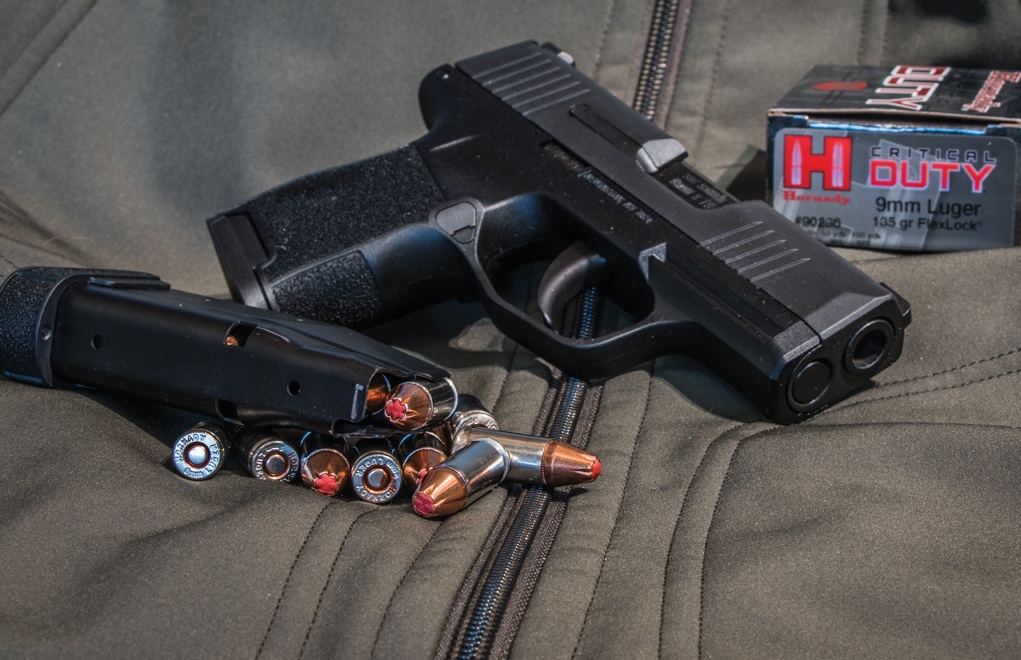
Pros
- Great sights
- Excellent Capacity
- Optics-ready options
Cons
- Ships with only one pinky extension
P365 Specs
- Caliber: 9mm
- Capacity: 10+1
- Barrel Length: 3.1 inches
- Overall Length: 5.8 inches
- Overall Height: 4.3 inches
- Overall Width: 1.1 inches
- Weight: 17.8 ounces
- Sights: XRAy3 Day/Night Sights; Optics Ready
- MSRP: $600
Is it fair to say this is the pistol that changed the face of concealed carry? Honestly, it’s not too much of a stretch. The Sig P365 has proven among the most monumental handguns to hit the market in a spell, serving up what many consider the perfect on-person self-defense package. That is a tall boast, but one the demure 9mm more than fulfills.
Above all, what makes the P365 such a spectacular heater is its size. The 3.1-inch barreled pistol is a mere 1 inch in width and tips the scales at a scant 17 ounces or so, creating one of the most concealable and easy-to-carry pistols out there. Sure enough, there are concealed carry guns, but in nearly every case they’re a compromise in power or capacity. Not so with the P365. Shipping with two 10-round magazines, the mighty mite has a payload identical to many compact models that come in nearly twice its size. Not enough on tap? Simply solved, given there are 12- and 13 or 15-round extended magazines available to improve your firepower.
Shooting-wise, the micro-compact shocks for a pistol its size. An abbreviated sight radius provides a challenge for those unfamiliar with the touchiness of small guns, yet Sig arms shooters with the tools to keep it steady. In addition to aggressive grip texturing, the striker-fired’s respectable trigger ups the gun’s accuracy potential. To boot, the 9mm is also quite easy to manipulate—an often overlooked asset.
Another point that sets the P365 apart from the rest of the micro nines and concealed carry guns in general is its modularity. The gun's fire control unit is interchangeable, in turn, you can upsize or downsize the grip. Furthermore, this feature allows you to swap parts from other P365 models–of which there are many–to create your perfect pistol. However, we can promise the outcome will look good.
As for nits to pick, the gun is stout in recoil, but no more so than any other micro-compact. And Sig only includes one pinky extension with the pistol. Even with medium-sized hands, I find the P365's grips too short for comfort.
These points aside, there's little arguing Sig cooked up a game-changer with the P365.
Read our complete Sig Sauer P365 review and see if the pistol is right for you.
P365 Deals
Runner-Up: Springfield Hellcat

Pros
- Excellent capacity
- Aggressive grip texture
- Affordable
- Optic-ready and compensated models are available
Cons
- Snappy recoil
- Gritty trigger
Hellcat Specs
- Caliber: 9mm
- Capacity: 11+1, 13+1
- Barrel Length: 3 inches
- Overall Length: 6 inches
- Overall Height: 4 inches
- Overall Width: 1 inches
- Weight: 18.3 ounces
- Sights: Tritium/Luminescent Front, Tactical Rack U-Notch Rear
- MSRP: $600
As pointed out, the Sig P365 is a game-changer. The Springfield Armory Hellcat is proof. Quickly embracing the micro-compact concept, the Illinois concern cooked up a direct competitor to the popular Sig. In many respects, it produced a concealed carry gun option that runs neck and neck with the original.
No larger than a compact .380 ACP, the striker-fired is among the smallest 9mm options available today. By the tape, it measures 1 inch in width and 6 inches in length and weighs in at 18 ounces. Pretty dang concealable and easy to carry by anyone’s standards.
At the same tick, the Hellcat offers everything you’d expect out of a much larger concealed carry pistol—especially capacity. Out of the box, the 3-inch barreled pistol boasts more firepower than nearly anything in its class, shipping with an 11-round magazine. Invest in a 13-round extended-capacity magazine, well folks, you’ll holster an iron flirting with a full-sized pistol’s capacity.
Outfitted with adaptive grip texturing, the Hellcat offers a positive grip when you need it, yet the ability to reposition your hand when you need to. A flat-faced trigger combined with a featherweight break and short reset ups the pistol’s accuracy resume, as well as allows it to run when needed.
Breaking from the herd, Springfield opted for a slightly new sighting system, jettisoning the traditional three-dot sights for a U-notch. Similar in concept, the execution differs in that shooters place the fiber-optic front pipe in the white outlined U-notch. A fast and intuitive system, few will miss the old way of building a sight picture. Additionally, the OSP model offers a slide cut for mounting optics, if a red dot is more your cup of tea.
Read our Springfield Hellcat review and learn about the pistol from the inside out.
Hellcat Deals
Best High-end Carry: Wilson EDC X9
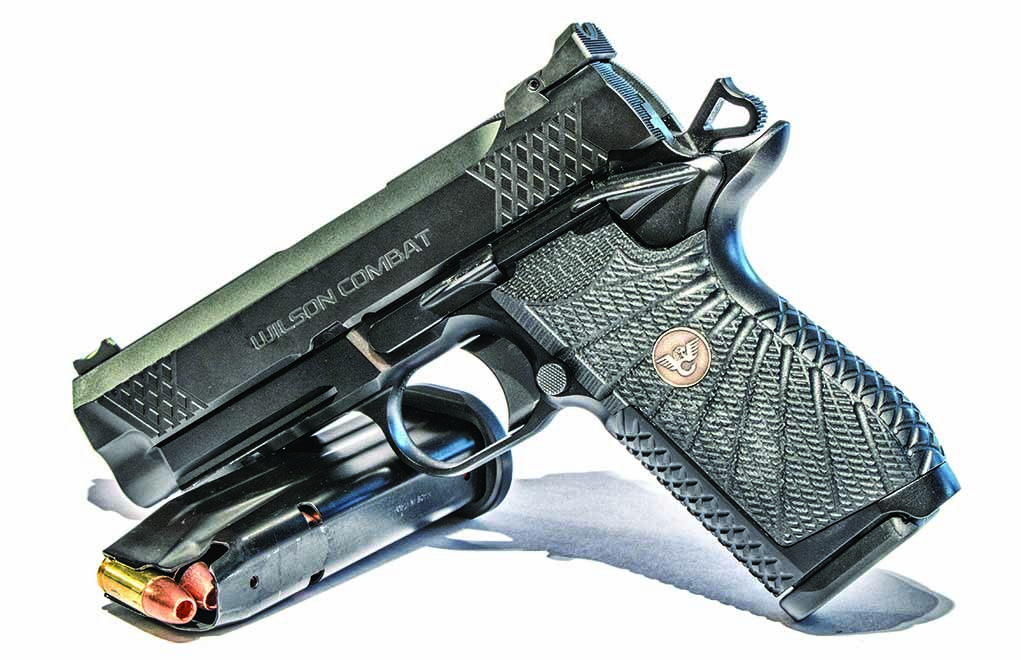
Pros
- Superior build quality
- Sublime trigger
- Factory customizable
Cons
- Expensive
- Heavy
EDC X9 Specs
- Caliber: 9mm
- Capacity: 15+1, 18+1
- Barrel Length: 4 inches
- Overall Length: 7.4 inches
- Overall Height: 5.25 inches
- Overall Width: 1.4 inches
- Weight: 29.09 ounces
- Sights: Tactical Adjustable Battlesight with fiber optic front sight
- MSRP: $3,3210
If you were to build a race gun to a concealed carry pistol’s specs, you’d likely come out with the EDC X9. This is the most highly tuned and performing pistol of our picks—with a price tag to match. But for the uncompromising souls looking to protect their six, the pistol is a perfect match.
At its core, Wilson Combat’s 9mm is a 1911, but one upgraded for modern self-defense. To the traditional side of the design, the hammer-fired gun inherits the exceptional 1911 trigger, which is light and fast. Unlike the original, Wilson has stripped the grip safety—though, for obvious reasons, the gunmaker has kept the thumb safety.
The EDC X9’s ergonomics are impeccable with the gun fitting the hand perfectly and Wilson’s XTAC pattern grips further enhance the comfort while ensuring a firm hold. Its aluminum frame adds a bit of heft to the compact pistol, but it’s far from prohibitive—comparable to a Glock 17. And the weight is a blessing of sorts, making the X9 extremely mild-mannered.
Despite a terse 4-inch barrel, the pistol can accurately fire well past typical defensive ranges. At close quarters, it’s lights out. Not only does the trigger and heft of the gun aid with this but also its Wilson Combat Battlesight and fiber-optic front, which provide quick and clear target acquisition.
In testing, the EDC X9 proved highly reliable, handling a wide range of 9mm ammunition without issue—it chewed through everything from 115-grain ball to 147-grain hollow point without a hitch. Much of this is thanks to Wilson Combat’s Enhanced Reliability System, a proprietary system designed to optimize functioning with the varying power levels of 9mm ammunition.
We lay out a pretty good case in our EDC X9 review of why this pistol is money well spent.
EDC X9 Deals
Best Classic Carry: Glock 19

Pros
- Accurate
- Reliable
- Aftermarket parts
- Ease of maintenance
Cons
- Grip angle
- Plastic sights
- Mushy trigger
Glock 19 Specs
- Caliber: 9mm
- Capacity: 15+1
- Barrel Length: 4.02 inches
- Overall Length: 7.36 inches
- Overall Height: 5.04 inches
- Overall Width: 1 inch
- Weight: 21.16 ounces
- Sights: Polymer white dot front, outline rear
- MSRP: $600
It’s difficult to knock off the king. And certainly, the Glock 19 still has its place on the throne of best concealed carry guns.
While a larger option than many of the modern sub-compact options, I find it difficult not to love how this momma-bear option operates. It’s still very concealable, at the same tick, large enough to make it extremely manageable and accurate. Of the guns tested, this G19 provided some of the best groups at even longer engagement distances.
Not to mention, the pistol is almost boringly reliable. Perhaps this is one of the greatest achievements of the pistol, no matter what you feed it the gun will chew through it. Much of this is thanks to a painfully simplistic design that offers few opportunities for malfunctions to occur. The other bonus to this is facet, the gun is extremely simple to upgrade—if you happen to find what rolled out of the factory unsatisfactory.
Sights, I’d say are one of the areas many consider must-change—though the factory set isn’t unusable. Trigger is another one that can use some pepping up and upgrades are legion in this area. I’ll admit, I don’t hate the G19 trigger and it’s more than passible for a self-defense gun, but there are much better options out there.
One last point, while the Glock 19 is concealable—folks have been keeping it under wraps for decades—it is large by today’s standards. It’s 21 ounces unloaded and 1.26 inches in width and has a height of 5 inches. A bit of a load if you go jogging in your jorts.
See why it's still a classic in our full Glock 19 review.
Glock 19 Deals
Best Budget: PSA Dagger Micro
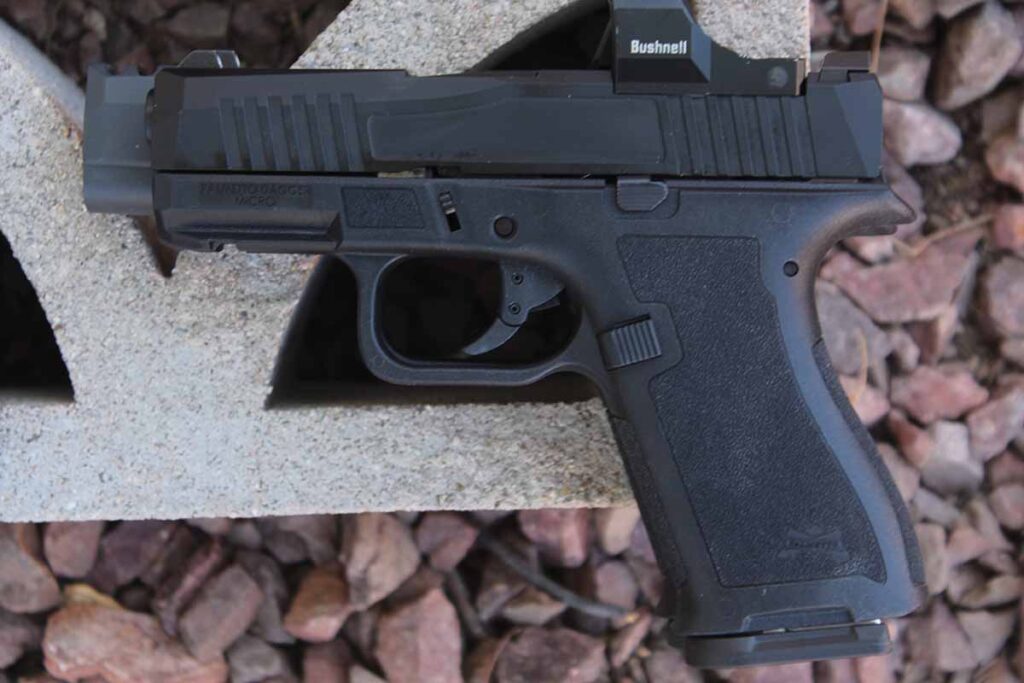
Pros
- Affordable
- Glock 43 compatibility
- Durable
Cons
- Ships with one magazine
- Few holster options
Dagger Micro Specs
- Caliber: 9mm
- Capacity: 15+1
- Barrel Length: 3.41 inches
- Overall Length: 6.5 inches
- Overall Height: 4.7 inches
- Overall Width: 1.1 inches
- Weight: 15.9 ounces
- Sights: Three-dot
- MSRP: $300
A remarkable blend of affordability, compactness and practical features, the PSA Dagger Micro hits a lot of the right notes. Surprising, given it’s the South Carolina concern’s first foray into this end of the market.
First off, as a budget concealed carry gun—one with a sub $400 price tag—don’t expect any originality. The Dagger Micro is what it is and that’s a Glock clone. Still, there are advantages to playing copycat, such as compatibility with G43, G43X and G48 pistols. And for those who have shot Glocks, well, by golly, the PSA carry gun should prove very familiar.
Overall, the pistol is fairly refined for the price point, with nice ergonomics, beveled edges and aggressive cocking serrations for enhanced manipulation. The trigger leaves a little to be desired—especially given the hinged bottom—but is responsive. And the grip is just right, with a sandpapery texture that keeps the gun where it should be—your hand.
Nicely, the gun ships with 15 round magazine, a significant upgrade over many in the compact class. Yet, PSA only gives you one. I suppose they needed to save money somewhere. And anyone familiar with the 3-dot sight system will know what to do when they pick up a dagger. Additionally, the pistol has an optic cut that accommodates Shield RMSc footprint optics for those who prefer red dot sights on their carry gun.
Reliability is another strong point for the Micro Dagger, it digested everything we fed it in testing. When it comes to a concealed carry pistol—no matter the price—this facet is priority No. 1.
Dagger Micro Deals
Best Carry Revolver: Ruger LCR

Pros
- Highly concealable
- Reliable
- Good double-action trigger
Cons
- Integral sights
- Double-action trigger not great for begginers
LCR Specs
- Caliber: .327 Federal Magnum; other calibers .22LR, .38 Special, .357 Magnum
- Capacity: 5-8 depending on caliber
- Barrel Length: 1.87 inches
- Overall Length: 6.5 inches
- Overall Height: 4.5 inches
- Overall Width: 1.28 inches
- Weight: 13.5-17.1 ounces depending on caliber
- Sights: Ramp front, integral rear
- MSRP: $739-$859
Despite rumors otherwise, the self-defense revolver isn’t dead. Or it hasn’t been since Ruger introduced its LCR (Lightweight Compact Revolver).
The minute snub-nose nearly single-handedly breathed life back into the flagging defensive revolver market when it hit the scene in 2009. And why not? At 13 to 17 ounces in weight and 6.5 inches in overall length, it is among the most concealable guns on the market today. This, in some respects, also gives it a dual purpose—not only is it a capable primary concealed carry gun, but it’s also svelte enough to serve as a backup.
Aside from concealability, the Ruger has also enhanced one of the key drawbacks of the double-action-only revolvers—its trigger pull. The gun utilizes a friction-reducing cam that lightens the trigger pull considerably and makes it surprisingly smooth. Even so, it’s still a stout 8 pounds to trip the hammer, which might not prove ideal for those brand new to shooting. Also, the sights—an integral rear and blade front—aren’t the easiest to master for more precise shooting. But at defensive range in defensive scenarios are more than adequate.
Ruger offers a bevy of chambering options for the LCR, from .22 LR up to .38 Special and 9mm. Though it’s a bit of an oddball, we liked the gun in .327 Federal Magnum, a hard-hitting compromise that is forgiving in recoil.
Our Ruger LCR review show why this revolver is such a hot-shot (especially in .327 Fed Mag).
LCR Deals
Best .357 Magnum: Ruger LCRx 3-Inch
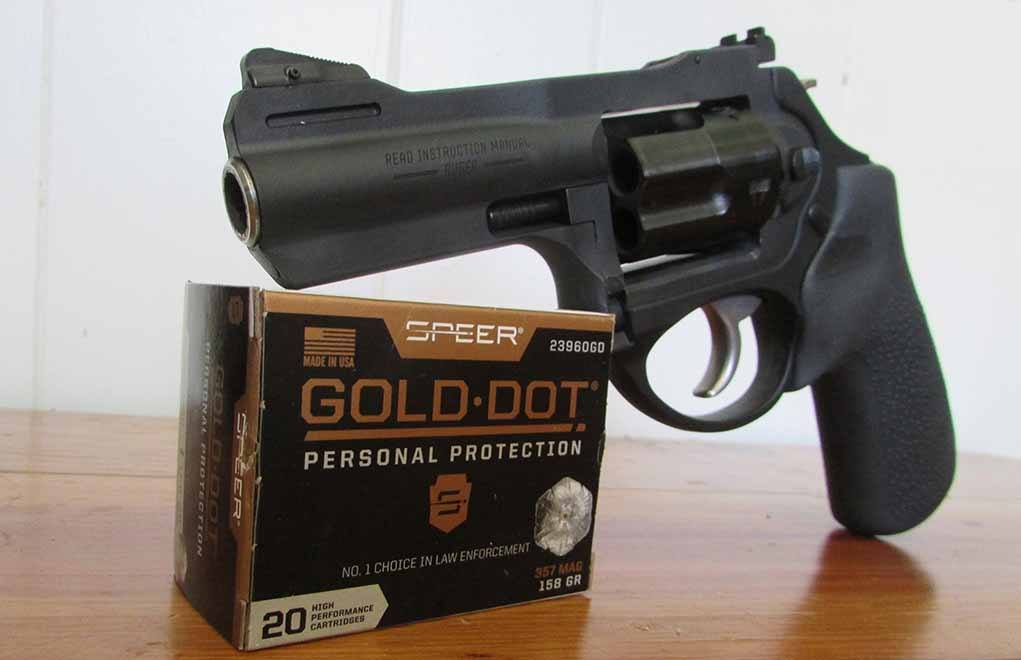
Pros
- Good ballistics
- Accurate
Cons
- Limited capacity
- Double-action trigger not for beginners
LCRx 3-Inch Specs
- Caliber: .357 Magnum; other calibers 9mm, 22 WMR, 22LR, .38 Special
- Capacity: 5-6 depending on caliber
- Barrel Length: 3 inches
- Overall Length: 7.5 inches
- Overall Height: 5.8 inches
- Overall Width: 1.28 inches
- Weight: 17.3 ounces depending on caliber
- Sights: Ramp front, adjustable rear
- MSRP: $859
The LCRx is the absolute mamma bear magnum for concealed carry revolvers, offering shooters everything they want in a .357 Magnum—especially the power. The secret sauce here is the gun’s 3-inch barrel that milks the ballistic potential out of the magnum cartridge.
While the snub-nose .357s have more pop than a .38 Special, even a +P .38, it falls considerably short of the cartridge's normal performance standards. In return, you get more muzzle blast and pain. However, in my chronograph testing, the LCRx is just off a 6-inch .357 Magnum and dang near identical to a 4-inch model. All while being quite a bit more concealable.
The 5-round revolver is heavier than its little brother LCR, coming in at 21 ounces. This isn’t only due to the extra bore, but also the stainless steel frame—required for the more powerful cartridge. Despite this, it remains very concealable.
The trigger is similar to the LCR, making the gun manageable and accurate—though it still isn’t an option for those who haven’t mastered the double-action trigger pull. There are other aspects shooters should keep in mind with the revolver, as well. It has adjustable target rear sights, providing more accuracy. And its hammer has a spur. While I haven’t found either to pose a problem, each are a potential snag point and might prove uncomfortable for some, depending on how they carry. At 5 o’clock outside the waistband, it wasn’t an issue for me.
Does the extra inch matter? Check out our LCRx review to find out.
LCRx Deals
Best .380 ACP: Ruger LCP Max

Pros
- Extremely concealable
- Capacity for size
- Good holster selection
Cons
- Short sight radius
- Small grip
LCP Max Specs
- Caliber: .380 ACP
- Capacity: 10+1
- Barrel Length: 2.8 inches
- Overall Length: 5.17 inches
- Overall Height: 3.6 inches
- Overall Width: .82 inch
- Weight: 10.6 ounces
- Sights: Tritium front, u-notch rear
- MSRP: $479
The third version of this iconic .380 pistol finally delivers what shooters have asked for, particularly its sights. I can't say enough how much I disliked the integral sights on the LCP II (now a .22 LR in Ruger’s catalog). Not only do I not care for fixed systems, but they provided only a rudimentary sight picture. On the other hand, the white outlined rear sight of the Max and tritium front creates a very usable and intuitive system.
One of the best features of the Max is its excellent capacity for what is certainly a pocket pistol. With 10+1 on board with its flush-fit mag and 12+1 with its extended, shooters should feel comfortable with its firepower. However, Ruger slightly widened the LCP’s grip to expand it to a double stack. Not that this is a bad thing. With a little more meat on the handle I found the pistol more comfortable in the hand; add the extended mag and even my medium-sized hand could fit almost completely on the grip.
I had no issues hitting center mass out to 10 yards with the Max, even so, I wouldn't classify the pistol as a tack driver. I don’t think this surprises anyone with a 2.8-inch barreled gun, weighing all of 12 ounces loaded. And while it's not a beast to shoot by any stretch of the imagination, it’s also not one I figure most folks will take to the range for fun.
All of that said, what the gun lacks in shootability it more than makes up for in concealability. I toted the Max around via a pocket holster and an IWB holster, both are more than feasible and comfortable. Short Speedos, you can carry the Max confident you won’t give yourself away.
LCP Max Deals
Easy To Manipulate: Smith & Wesson Equalizer
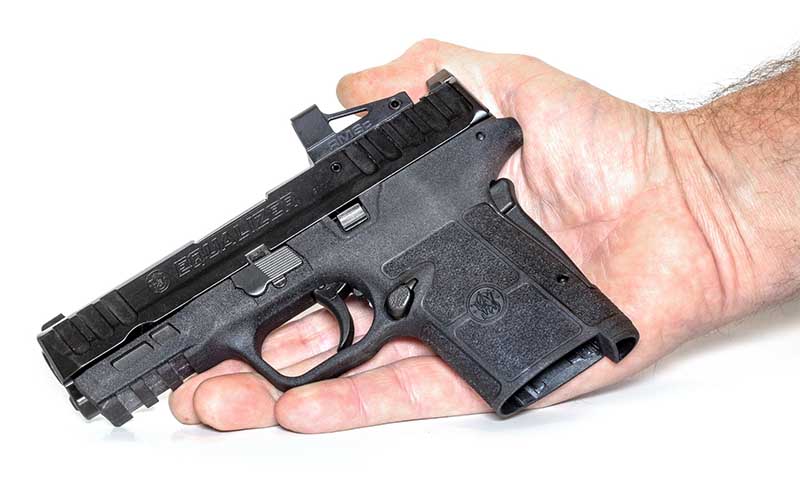
Pros
- Easy racking slide
- Optics ready
- Low recoil
Cons
- Grip Safety
- Reset not very audible or tactile
Equalizer Specs
- Caliber: 9mm
- Capacity: 10+1, 13+1, 15+1
- Barrel Length: 3.68 inches
- Overall Length: 6.75 inches
- Overall Height: 4.5 inches
- Overall Width: 1.04 inch
- Weight: 22.9 ounces
- Sights: White dot, optics read
- MSRP: $599
Easy-to-manipulate semi-auto concealed carry pistols have earned a much-needed niche in the firearms world. There are plenty of folks—through age, infirmity or just plain hand strength—who find semis difficult to manipulate. Smith & Wesson took a hard look at this class of pistol and developed the best example yet.
OK, so emblazing its name—Equalizer—across the slide is about as attractive as tailfins on a Corvette. That, however, is a rare chink in the 9mm pistol’s armor. Living up to its name, nearly anyone can operate the slide and get the gun into action.
While it appears just another striker-fired compact, the design point that makes the pistol so manipulatable is that it's hammer-fired. Essentially, it’s a Shield EZ—long-time S&W favorite—but a double stack, shipping with 10-, 13- and 15-round magazines. Aiding the pistol’s operation externally are large and aggressive cocking serrations and cocking tabs at the rear.
Honestly, I have to admit, the pistol is a shockingly nice one to shoot. Accuracy-wise, I found it on par with S&W's popular M&P line, but with a much crisper trigger—one of the benefits of a hammer. Certainly, the gun is on target enough for defensive action. The Equalizer also lives up to its billing with its highly manipulatable slide that able hands can run lighting fast.
A drawback I found to the system is holstering the pistol. Too much tension on your holster, the gun can rack when put away. I found counter pressure on the back of the slide with my thumb eliminated this issue.
Small and slick, find out more in our Smith & Wesson Equalizer review.
Equalizer Deals
Best Backwoods Carry: Glock 20
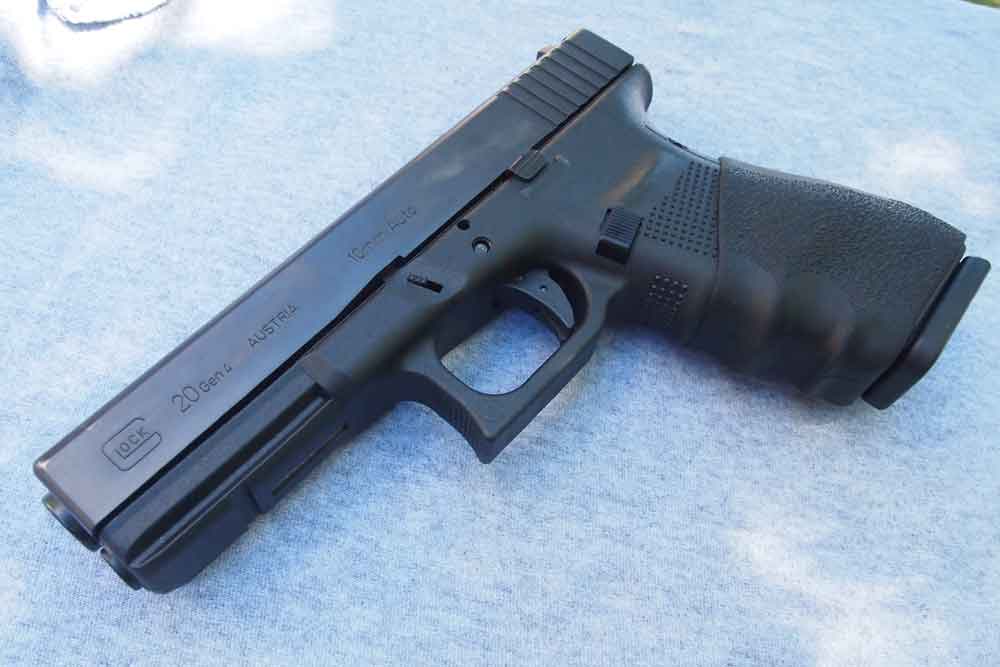
Pros
- Powerful chambering
- Reliability
- Versatile
- Extended range
Cons
- Large
- Longer trigger reach
- Recoil
Glock 20 Specs
- Caliber: 10mm
- Capacity: 15+1
- Barrel Length: 4.61 inches
- Overall Length: 8.07 inches
- Overall Height: 5.51 inches
- Overall Width: 1.12 inch
- Weight: 39.86 ounces
- Sights: White dot front, white outline rear
- MSRP: $599
Most only consider two-legged predators when shopping for concealed-carry guns. Certain circumstances call for a pistol that can handle more than upright threats. For backwoods protection, the Glock 20 exceeds nearly all others.
A 10mm, the pistol provides enough punch to batter your way out of the tightest situations and take everything down short of coastal brown bears. Even there it’ll likely make them think twice. At the same time, it is feasibly concealable, particularly in garb you’d wear into the hinterlands. That said, it’s no lightweight by carry pistol standards—weighing in at a hefty 30 ounces unloaded. A good gun belt and perhaps an OWB holster go a long way in making the G20 a more manageable CCW gun.
Surprisingly, the G20 is a very manageable pistol, even with pitching hot loads. The weight does its part in taming the 10mm's jump, but so do the grip's ergonomics. Get past the Glock rake—of which I’m no fan of—and the standard model fits medium to large hands well and offers enough texturing, including the front and back straps—to keep the gun in place. I can take or leave the finger grooves.
It’s also lights-out accurate, particularly the MOS model outfitted with a red dot. With practice and a good trigger squeeze, the gun can consistently hit well past most defensive ranges. However, for many, tight and accurate splits may take some practice.
Hogs, cougars, two-legged threats—the G20 has you covered.
See how this 10mm is on the hunt with our Glock 20 review.
Glock 20 Deals
Concealed Carry Handgun Buyer's Guide
Concealed Carry Lifestyle
Above all, becoming an armed citizen is a lifestyle choice. By this we mean, your life will conform around your concealed carry gun. Don’t let this scare you off. It’s less daunting than it seems, yet it merits comment.
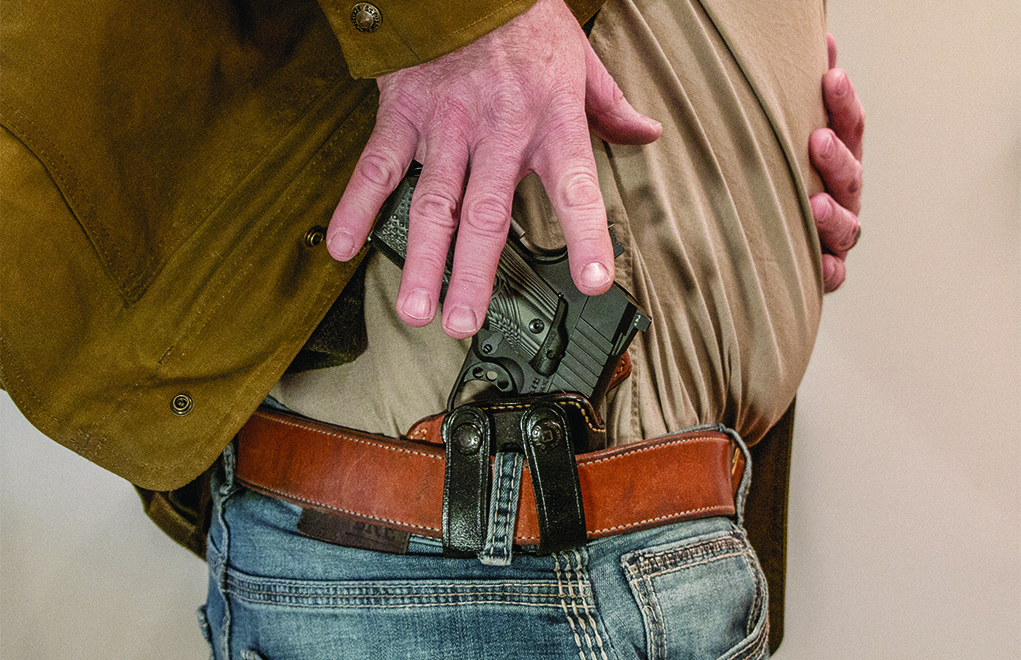
After purchasing a concealed carry gun, plan on finding a reputable firearms instructor and enrolling in his or her classes. Generally, they’ll offer different levels of training, from basic pistol courses many states require to procure a concealed carry permit, to instruction on advanced concepts such as dynamic shooting, low-light engagements and mindset. Legal education is a must as well. America is a patchwork of self-defense laws, so be certain you find something tailored to where you live and travel so you have a well-formed idea of when, where and how you can justifiably use lethal force.
The greatest demand going armed makes is mastery of your firearm. Just like buying a guitar doesn’t make you a musician, purchasing a concealed carry gun doesn’t make you an expert in self-defense or the use of lethal force. You must educate yourself, practice and continue doing so. Essentially, it’s a lifetime undertaking. Don’t throw up your hands, because it’s the hardest work you’ll ever love with a side benefit of a lot of range time.
Once you have basic instruction under your belt, plan on refresher courses in the future. In the meantime, practice. We won’t prescribe a particular regimen here, because it will differ for each armed citizen. Your training should result in knowing your concealed carry gun inside and out, from muzzle to butt and all the quirks in between. Range time is the most obvious arena for learning and excelling with your pistol or revolver. But a solid routine of dry-fire drills at home works miracles on a learning curve and doesn’t cost a thing.
The other lifestyle aspect that comes with a concealed carry gun is clothing. Yup, that wardrobe is going to need updating … most likely. Unless you’re still mired in the baggy days of the grunge movement, it’s a safe bet much of your wardrobe won’t keep your gun concealed. Or, if it does, you’ll feel plum uncomfortable. Again, we won’t touch on the fine points here—there are loads of them. Just expect to make a clothing investment along with your concealed carry gun.
Concealed Carry Holsters
Hand-in-hand with clothing is a holster. You didn’t think you were going to tuck that baby in your waistband naked, did you? This is a vast topic, given the numerous types of concealed carry holsters on the market today:
- IWB
- OWB
- Shoulder
- Ankle
- Belly Band
- Various Off The Body
Each has pros and cons and fit certain armed citizens, but not all of them. However, essentially all of them do the same job: retain the gun, cover the trigger (among the most important), protect you and the gun, enhance concealability, make carrying comfortable, and facilitate a smooth draw and re-holster. That’s a mouthful.
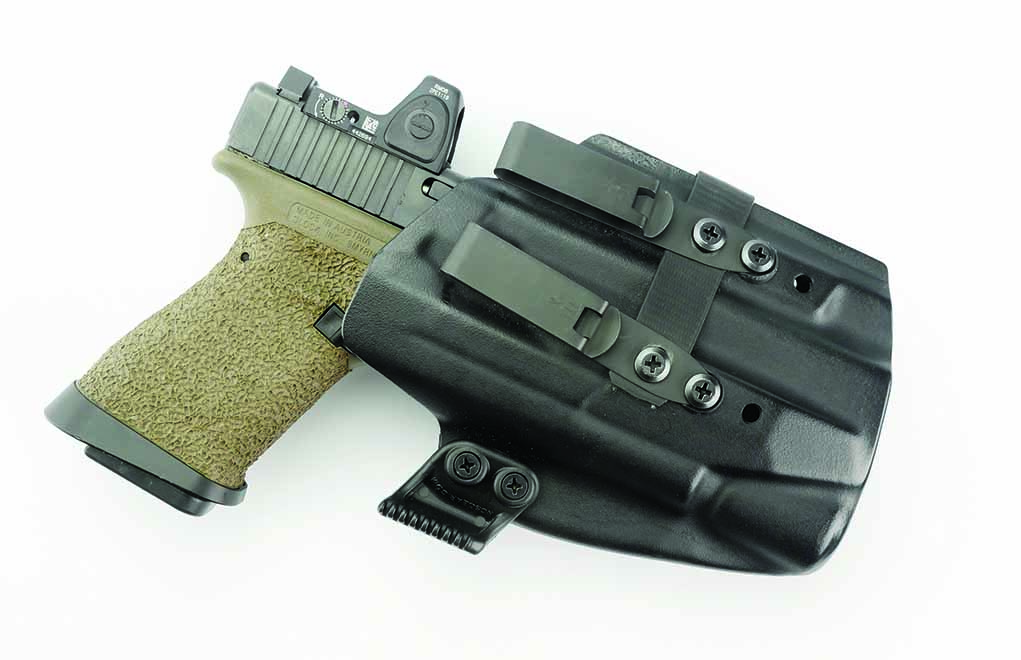
Stick with Kydex for your AIWB holster. Leather will become soft over time … which is a bad trait for an appendix rig.
Kydex is almost always a solid choice for holster material.
Unfortunately, we don’t have the magic bullet so that you hit the perfect holster your first time out. Nobody does. All we can say is, expect plenty of trial and error—and a closet shelf of rejects—before you find the ideal hanger for your concealed carry gun.
CCW Gun Fit
No two concealed carry guns are alike nor are two armed citizens. In turn, the pistol that works for you might be unwieldy to your friend. What this comes down to is fit, and there are two basic factors pertaining to concealed carry guns.
- How the gun fits your hand
- How the gun fits your style of carry
Most new shooters tend to think all guns are alike. They pick a trustworthy name and assume all is right with the world. Nothing could be further from the truth.
Concealed carry guns need to fit your hand properly, facilitating a fundamental high grip, otherwise, there can be control issues. Even the relatively mild-mannered 9mm is jumpy if oversized compared to a particular shooter. Gunmakers have engineered some wiggle room into their guns; most new polymer-framed pistols come with replaceable backstraps and palm swells of different sizes allowing for a level of customization. Take the time to find the make/model that fits you best. A good tactic is to go to a range that has a good selection of guns for rent, and give the ones you’re interested in a test drive. The proof is in the pudding, as they say.
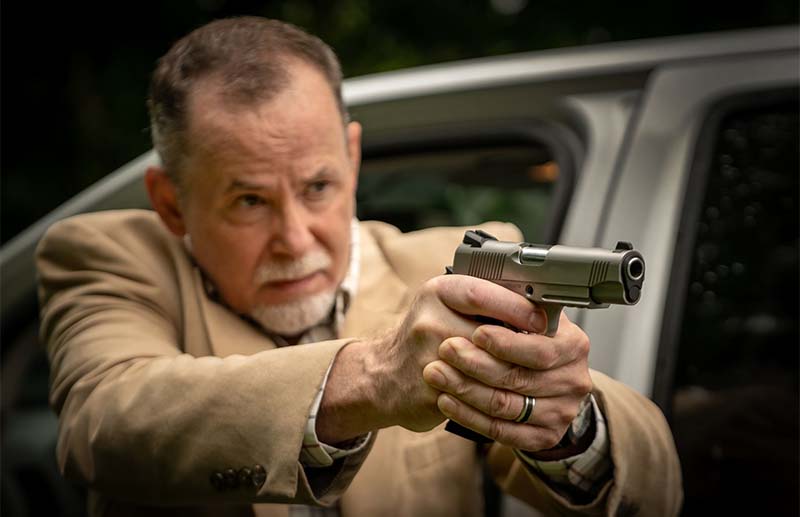
As to carry fit, the whole idea behind a concealed carry gun is to keep it concealed. Depending on who you are, how you carry and your particular lifestyle, not every gun will fit the bill. While a 250-pound trucker might easily keep a Government-size 1911 under wraps with no problem, a 98-pound lady business executive might find it more challenging. Think hard about your usual attire (yes, you’ll update some of it), daily routine and potential carry methods as you go through the buying process. These will provide guide marks steering you to the ideal choice out of all the concealed carry guns.
The Best Caliber For Concealed Carry
Hoo boy … here’s a can of worms. Ask 100 people the best caliber for a concealed carry gun and you’ll get 100 answers—probably including 8.5 Mars, .455 Webley and some other oddballs. The topic is so divisive friendships have been lost and gun forums burned to the ground arguing what’s top dog. Presently, the most popular concealed carry calibers are:
- .380 ACP
- .38 Special
- 9mm
- .40 S&W
- .45 ACP
- 10mm
- .357 Magnum
So, which one is right? The dirty secret is, all of them.
Given ammunition advancements over the past 20 years, particularly bullet design, every one of the cartridges can save your life. The rub is, some of the smaller and lower velocity options—.380 ACP and .38 Special, we’re looking at you—require more homework to find acceptable self-defense loads. The big boys—10mm and .357 Magnum—require more skill to wield effectively. Don’t let either factor turn you off any of those if the particular concealed carry gun that fits you is chambered thusly. Just expect to spend more time making them work.
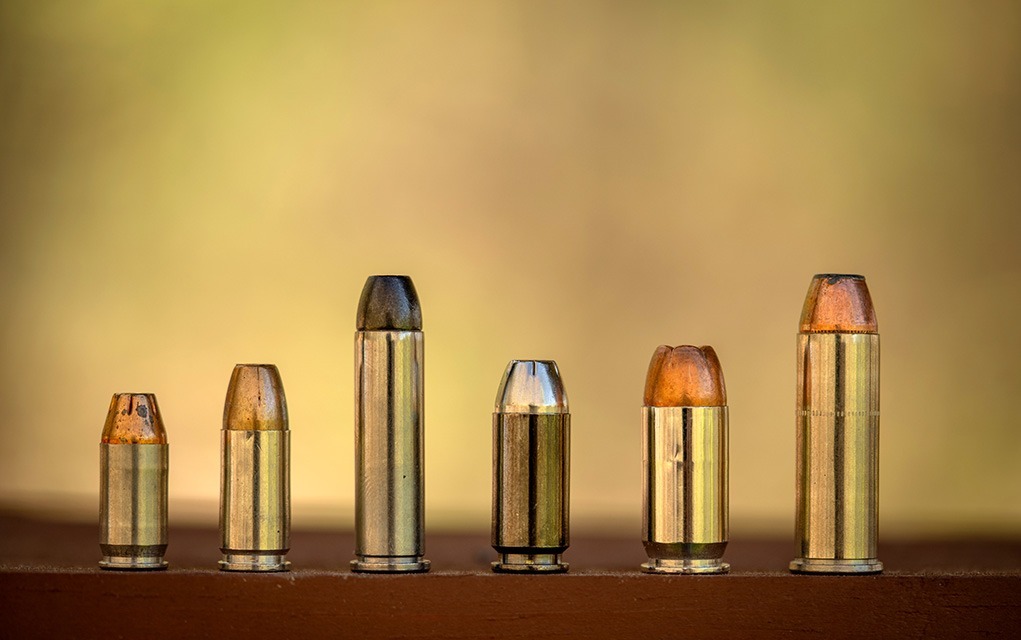
That leaves us with 9mm, .40 S&W and .45 ACP. These are the most popular self-defense calibers on the market. Again, we can’t choose for you, only point out each that is an effective option, capable of neutralizing a threat, and are widely available. You need to find what you shoot best and that comes in a make/model that fits your lifestyle. A range that rents guns is invaluable for puzzling this out. Take each for a spin before you buy!
What about a .22 LR and other small fries? While inadvisable for most armed citizens, if that’s all you can get or effectively shoot, it’s better than nothing.
Expand Your Knowledge on Concealed Carry
- Best Concealed Carry Gun for Women
- Must-Have Concealed Carry Upgrades
- Best Concealed Carry Insurance – CCW Insurance Options
- Concealed Carry Optics – Red Dot, Green Dot, or Iron Sights?
- Concealed Carry Holsters for Women
- Best Concealed Carry Holster
- Best Pocket Holster – Options For Easy Everyday Carry
- Concealed Carry Shoulder Holsters – Best Up-Top Carry Options
- AIWB vs IWB Holster – Pros & Cons
- Concealed Carry Fanny Pack – Pros & Cons for Everyday Use
Best Concealed Carry Guns FAQ
Compact pistols have a 4-inch barrel and micro compacts a 3- to 3.5-inch barrels. We find these lengths the easiest to carry. However, the longer the barrel of a gun the more accurate it is due to a longer sight radius. In turn, the best length for a pistol is one that facilitates the most accuracy, while being easy to conceal.
There is no consensus on which caliber is the best, though, the 9mm is the most popular. For the most part, .380 ACP is considered the minimum caliber for self-defense.
One that completely covers the trigger, for starters. Aside from a way to carry your concealed carry gun, a holster is a safety device. From there, much of it is a personal preference. I personally prefer inside the waistband (IWB) holsters, because they provide the most concealment. However, in the colder months, I will use an outside the waistband (OWB) holster for comfort.
While many gun salesmen push small and light revolvers, my choice for most women would be a compact or micro compact pistol. The trigger pull is lighter and more predictable. For women concerned about being able to manipulate the slide, the Smith & Wesson Equalizer would be my first choice; for those looking for less recoil, the Springfield Hellcat with a compensator would be an excellent option.

Next Step: Get your FREE Printable Target Pack
Enhance your shooting precision with our 62 MOA Targets, perfect for rifles and handguns. Crafted in collaboration with Storm Tactical for accuracy and versatility.
Subscribe to the Gun Digest email newsletter and get your downloadable target pack sent straight to your inbox. Stay updated with the latest firearms info in the industry.
Why You Can Trust Gun Digest
Since 1944, Gun Digest has been a trusted authority on firearms, shooting and shooting gear, delivering expert firearms reviews backed by nearly a century of experience. We go beyond standard reviews, combining hands-on independent gun testing, in-depth research, and expert insights from industry professionals and manufacturers.
Our reviewers are the bedrock of our testing and come from a comprehensive cross section of the shooting world. Their diverse backgrounds include law enforcement professionals, military veterans, competitive shooters, seasoned hunters and life-long firearms enthusiasts. In addition to being firearm experts, we are also thorough journalists adhering to the strictest standards of the profession.
For our readers, this means objective, unbiased reviews, free from outside influence. Our priority is to provide the information you need to make informed decisions—whether a firearm or piece of gear is a must-have investment or one to pass on.
Find out more about our Editorial Standards and Evaluation Process


![Best Concealed Carry Guns In 2025 [Field Tested] Wilson Combat EDC X9S 1](https://gundigest.com/wp-content/uploads/Wilson-Combat-EDC-X9S-1-324x160.jpg)


![Best 9mm Carbine: Affordable PCCs [Tested] Ruger Carbine Shooting](https://gundigest.com/wp-content/uploads/Ruger-Carbine-Shooting-100x70.jpg)
![Best AR-15: Top Options Available Today [Field Tested] Harrington and Richardson PSA XM177E2 feature](https://gundigest.com/wp-content/uploads/Harrington-and-Richardson-PSA-XM177E2-feature-100x70.jpg)

First of all, I can’t believe that none of these guns are actually subcompact except for the Springfield hellcat and the sigsauer P365, which is a great gun. I’m partial to six so being from New Hampshire six hours are extremely expensive and I don’t know why anyone would carry a 9 mm For concealed carry when they could carry a 45 ACP also the P3 65 doesn’t have a safety at all which at least the hellcat and the G 30 have triggered safeties even though they’re basically useless. They won’t go off if you drop the gun.
Makes that two. Myself included. I’ve carried like forever.
For me, carry depends on weather. In hot weather, or when in dress clothing mine is a Sig P238 in .380 caliber. Just put it in my pocket with a thin pocket holster.
With Jeans, same thing, but I will carry a Sig P938 in 9MM. Both have stainless slides for less scratches and such.
When it cools down and I wear a jacket or winter clothes I change to a Glock 26 with a mag extension on a Belt holster.
All of these guns are baby little 9 mm pussy guns the best concealed carry pistol hands-down is a Glock 30. It’s chambered and God’s caliber 45 ACP it’s just as many rounds as any of these 9 mm sub compact’s it’s basically the only subcompact double stack 45 ACP handgun in the world there might be one or two others but it’s a Glock so it’s reliable. It’s a double stack 45 that holds 10+ one in a flush fit magazine or 13+ one in a full-size grip it’s striker fired so there’s no pesky hammer to get caught on anything. It’s basically the hellcat or the P365 but in 45 ACP. The rest of these guns are compacts not subcompact so they can’t even fit in your pocket. They’re not really concealed carry guns. Their women’s guns there for people with small hands. The only con with the Glock 30 is the same with any striker fired firearm is it doesn’t have an actual safety. They call it a trigger safety, but it can be defeated by an infant. It’s not a safety. you have to depress it to pull the trigger anyway I believe that all gun should come with a de Cocker style safety like the Ruger P series or the Beretta M9 or 1911’s that is an actual safety that cannot be defeated by just pulling the trigger I would never ever carry any gun that only has a trigger safety or even a beaver tail safety like a Springfield XD 45 that’s a sub compact single stack 45 ACP with a Beavertail safety and a trigger safety. I still wouldn’t carry that gun with a round in the chamber because you defeat the Beavertail safety by holding it by the handle And you defeat the trigger safety by pulling the trigger the only thing with the XD 45 is it has a chamber loaded indicator which is cool all done should have a chamber loaded indicator like the Ruger P series the Ruger P series is basically the perfect gun except it’s hammer fired. They’re all hammer fired every single one if they were Striker fired, they would be the perfect gun because they have a deCocker style safety it even comes with a key that locks the safety that way if your kid gets a hold of it they can’t shoot themselves. They can’t shoot anything because they can’t take it off safety without the key, but that also means if someone breaks in your house, you have to find the key and put it in the de Cocker in turn it 45° to unlock the safety before you can then flip the safety up and defend yourself, but that’s the only downside of a Glock any Glock I would never carry a Glock with a round in the chamber. In my opinion Glocks are not safe enough. The trigger safety is not a safety at all it makes no sense you’re going to pull the trigger anyways which means it’s ineffective. But as far as capacity and stopping power and reliability as far as subcompact pistols go, the Glock 30 G 30 is the best gun you can buy it fits in your pocket. It holds 10+1 of 45 ACP you just have to pull the slide back and you’re ready to go. Only an idiot would carry a Glock with a round in the chamber. It doesn’t have an actual safety, but it’s still better than anything else on this list.
M&P shield hands down.
100%, they are on top right now. Under $1k, no one can touch them, it’s crazy.
Good article. Very thorough and great info. Thanks.
I purchased a RUGER LCR 327 a few years ago for just over $300 and a RUGER LCP MAX 380 for $239 on 30 DEC 2024.
I am surprised the M&P shield isn’t on this list. I don’t know about other areas but 327 magnum ammo is scarce so I wouldn’t consider something I can’t get ammo for a good option. Lastly the very beginning of the article says Ruger LCP2 but further down the author says they don’t like it and give no specs. Instead talks about LCP max that isn’t on the top list.
I’d choose a Glock 43x or 48 over a Sig 365 allday…everyday.
The owner of the site probably wont read this but I still have to make this comment:
IT IS INCREDIBLY LAME to put a ffin video on your site and having it on autoplay. Every single time I open an article, that video starts playing, blasting into my ears. ARE YOU CRAZY?! WHY? STOP IT! This isn’t a ffin mypsace page for f sake, man!
I like guns, but I always feel bad for the people who are so scared of everything and have to always carry one.
Live in a better place. (Move)
Be nice to everyone
Drive right.
Say sorry
Offer to help.
Stay away from crazy people. I know they are fun..but…
Oh, people who like drama…yep, I know they are fun…but…
Maybe I am the one scared, I go to the movies in the mornings. I don’t go to restaurants on the weekend. Clubs…Not much…unless they have a huge name.
I use a service to take me from one place to another. My hotels have great security.
I also have damaged my body so bad with weight lifting and MMA stuff that it hurts on workout days. Oh well, this weekend I had fun with a bunch of guys 20 years younger than me, which freaked them out that a 50 year old can so quickly own them.
Can someone sell me some stuff to fix my joints and ligaments?
I checked all your boxes and I still carry everyday. If I knew when I needed to carry, I would only carry at that time or stay home.
Right on!
It’s not that we’re so scared that we carry everyday, we carry as this world has gotten so bad. Point being a lady got shot and killed cause this other lady wanted an item for sale on a Black Friday sale after thanksgiving. A 50$ toy and this lady died, if we all considered getting certified to conceal carry this would have happened to the one lady. Getting killed over a pair of shoes, the list goes on. I carry to protect my family and myself, I will do what I need to to protect my family, myself and others who need protecting. So don’t feel sorry for us who carry responsibility, feel sorry for the fools who think they can try to take what’s not theirs, try to hurt those around me. I will send them to meet their maker and be judged then. It’s pitiful a person will get maybe 5 years in prison for murder and if the kill a dog they get 20 years. They say the dog can’t properly defend themselves, well the people who were killed couldn’t properly defend themselves either!!!!! Point is Chicago Illinois where there is no guns allowed there, law abiding citizens are killed daily as they follow the law of no guns, the criminals don’t follow and have guns. I personally think everyone should be allowed to open carry a pistol, have a rifle or shotgun in their homes. Bet the killings would go way down if it was a law that 18 and up had to follow, no more school shooters, people killed for no reason. The draw back is no one been to prison, domestic violence, hurting kids would be allowed this opportunity to carry or own. If they do and caught they would go back for life or get shot. This would stop all the stupid shootings in the United States.
What about the j frame sw model 640. A little heavy, but it’s fireable because the recoil is controllable with 38 spcl. Concealable with Mika custom holster for pocket carry.
No Berettas? No Nano? No 32 Tom Cat? No Storm sub-compact? I carry a Storm sub in 40 caliber either on my hip or even in my pocket in a “sleeve” holster even in summer wearing shorts & a tee.
I love the storm, I have both the full size LE model and the compact size and once owned the Sub as well. Having owned and shot all3 Beretta PX4 Storm models I would not carry a Storm Sub .40 S&W because the revolutionary piece of the PX4 Storm is the rotating barrel mechanism which reduces felt recoil and increases accuracy, this is not present in the Sub Compact models. Without it most of these other guns will outclass it in terms of he qualities expect of an EDC CW. Compactness, Recoil, Accuracy, etc… However if you don’t mind a slightly larger EDC or wish for a larger caliber. The Compact PX4 Storm .40 S&W is absolutely the way to go, I carry the full and my wife carries the compact. Again, I repeat the Sub-Compact does not have the rotating barrel, only the Compact and Full Size models have this feature.. if your seeking .40 S&W or .45ACP then you should try this firearm because the recoil is reduced dramatically. My .40 S&W has similar felt recoil to most 9mm pistols.
fixe the drelvery location,
how to pay
no direct contact
The capacity is wrong for the. Wilson EDC X9. The magazine is 15 rounds and they also have a 18 round mag. The one in the picture is a 15 round not 10
Tried literally every weapon on this list with the exception of the Kahr and the Bullpup. The S&W M&P Shield 2.0 Plus Performance model beats them all. It’s exclusion makes this list invalid in my mind, the only ones here that compare to it are the Hellcat and the P365.
Depending on my attire really drives what I want to carry concealed vs what I have to carry. Yes, full frame pistols or revolvers have an advantage at the range however at work during the summer time wearing polo shirts and slacks the Sig P938 works for me. During cooler weather when I can wear a sweater then a commander size 1911 or compact size polymer frame pistol works too. My gripe is how people select their self defense hand guns. They swear by manufacturer, caliber, etc.. and how accurate and reliable one may be over another. But judging self defense against a range target using your sights seldom cuts it in reality when under attack. Case in point: I went to the range with a friend who does not shoot well and has small hands. We laid out a variety of pistols, revolvers in many calibers. The drill was to pick one up rapidly fire 3 shots at a 10 yard target without using the sights to find out which landed the best grouping consistently. You would think my friend would end up with a small 9mm but in fact his best groups were by a Walther compact in 40 caliber. For me, a bigger guy with larger hands I found that a Sig 1911 in 357 Sig worked best. Yes, go with a quality gun manufacturer but experiment to find what works best for you and your grip size. Then that is the one you should carry. Hopefully you can conceal it easy enough too.
You were mistaken. The Kimber Evo holds 7+1, not 6+1.
How about mentioning the weight of every pistol?!! Idiots.
Rather strong language I would say for a list. Yeah, weight would be nice but that does not make the author an idiot.
WHY enter two RUGER pistols that are the least likely to be carried and omit the excellent 9 mm RUGER LC9s??
LET’S SEE YOUR CRITERIA FOR COMPILING THIS LIST!
I understand that gun magazines have to exhibit a certain degree of hype in order to continue to get advertising from the big brands. But having said that, I and my wife still love our Taurus G2Cs. Excellent guns that are reliable and accurate, as well as being very comfortable to carry, both ergonomically and in terms of carrying with a round in the chamber because they are SA/DA guns.
Any list for 2020 that does not have the Sig P365 really makes me question the list….
You need to look again .
Not a single Sig? The 365 is great. The 938 and the 238 are also better and more accurate than the PPK- which I also own.
The 365 is on the list.
Did I read this incorrectly?; “The .380 has a special place in the hearts of pocket carriers, with its slightly smaller diameter, often allowing one more round in the magazine than its 9mm cousin.” Are you honestly saying the .380 has a smaller diameter than the 9mm? You may want to get your calipers out and check that diameter again. There’s a reason the .380 was called the Browning 9mm Short.
The bullet might be the same diameter, but the case of the 9mm Luger is bigger (and tapers)
A great list… I do own an older Walther PPKS. I love it, no matter the lower round count, weight and 380. It does what I want and can be concealed well. I also own a FEG SMC 380 (PPK clone) and it is a good piece. I do want a small 9mm. My only 9mm is a Ruger P89… the Timex of 9’s…. just bulky. I do own 3 revolvers… Dan Wesson 15-2 but it is bulky. 2 38 spls.. old series Colt Cobra and a new Taurus 85 Lite. All are reliable. All my others are large frame large calibers..not concealed easily.
Right now I am thinking of a Sig P365 or even the Springfield Hellcat. Both small nines with decent capacity.
DJ, while trying to pare the list to just 11, it is a daunting task that has several GLARING omissions. The biggest one being the P365, admittedly plagued with a few issues Sig stepped up and made it right. This little guy caught everyone asleep at the switch and is still outselling any of your picks 5 to 1. Springer 9MM
I’ll stick with the old reliable concealable Glock 26. I don’t understand why it didn’t make this list.
always loved mine! carries well!
Can’t disagree with this list too much. I carry the Shield Performance Center (though usually a .357 EAA Windicator AND/OR USPc .45) but the gun that easily beats out my Glock 26, 19, Shield(s), and even USPc (in comfort for carry though both are quite easy) is the HK P30SK. Sure, the Walter, and imo the SIG P225 and P228/9 are two of the best ever for carry, but P30SK /w custom finger extensions (found on ebay) for 15 round mag along with flush 10 round and 10 round /w extension, grip config and mag extensions make it the most versatile and modular sub compact ever. Also the trigger works amazin in live fire, while underwhelming in dry-fire to some the SA really comes alive and allows for fantastic follow up shots. I’m a one-eyed asshole injured overseas in combat with quite a few other injuries so im rather particular about my firearms. Including the ones i used over there (sudeams in this case). For an easy walk for lower cap CCW the P30sk /w .357 snub as backup for that, or the SIG P225 pretty much takes it. SIG P229 still might be the best ccw/carry/duty weapon out there. The HK P30 and P30 L being the best grips and two of the very toughest and safest, yet fastest 9mm ever made in DA/SA
If we’re talking $1200-ish an HK P7 m8 has been something ive had in private security teams and wish i could have kept mine. The M13 too. The M8 is my #1 carry pick in 9mm for striker or DA/SA. P30 and 229 are equal and the Walter, Shield and new SIG sub compact (P320/365?) has up to 15 rounders and is the most natural point shoot ive felt in a new gun in awhile, and ive always dreamt of a single stack G19. So many great offerings these days, hard to go wrong! I will again say the SW Shield Performance Center is one of the most natural shooting pistols out there and feels like an American James Bond gun, lol
About the Walther PPK… Did the author have a stroke half way through the wright up?
“chambered in .380 ACP to hold a bit more ammo than the 9mm version”
Huh? There is no 9mm Luger version. 9mm Kurz is the German name for the .380acp (metric system and all). Then there is this nugget:
“However, for one extra round, pick up the sport (PPK/S) version that features a slightly longer grip” The “S” stands for “Speziale” which is German for special. The special is the American market after the 1968 gun control act. The lengthened grip was necessary to import the handgun.
You don’t have to know history since this is something that happened just a couple of years ago but when talking about the Glock 19x, this comment: “Sig P320 – with the drop safety issue apparently solved” is further evidence of a possible stroke. The M17 never had a drop safety issue. It’s safeties are different than those found in a plain Sig 320. There was no recall on the M17, from it’s inception it was perfectly fine.
I have a Taurus PT709 Slim and like it. Gun Tests magazine said they would buy it and they would wear it.
Not sure why Hitler offing himself with a Walther is relevant to carry concealed regardless, like JR Looney and Andrew, I do not understand why other options were not considered. Not for concealed, but I like the Springfield 1911, Beretta 92 and Sig 226. I believe there are better options than this list, but that’s my opinion … just like carried concealed does not necessarily have to be small.
At 6′ 2″ I have big hands and do not care for subcompacts. I do like the Sig P225, P229 compact, 320 compact, and a few others. 30 years ago when I was a cop, I carried a boot gun S&W 649 while carrying an S/A sidearm. I had to put larger Pac grips on the 649 due to the small wood grip.
Just an interesting piece of trivia that I actually enjoyed reading.
I know this is an opinion-based article, and therefore is completely unscientific, etc. …But to not see a single Sig Sauer on the list, like the P238 or P938 listed. Yes, they’re expensive, but as hardware goes, they are second to none. Both are ultra-concealable, the 1911-style SAO means that no trigger pull is gonna take so much effort that it screws up your aim (can’t say that about the M&P, for sure…). Plus most come with tritium night sights that are perfectly serviceable in both daylight and darkness.
I agree wholeheartedly!
I simply do NOT understand why people have this idea that a concealed carry handgun NEEDS to be an underpowered, and tiny handgun that is harder to handle than a mid or full size handgun.
I would rather carry a round that I KNOW will put a two- or four- legged varmint down with a minimum of effort, and rounds expended.
I am 5’5″ tall, and I have been carrying a full size Gov’t Model 1911 .45 ACP concealed for the better part of 40 yearsm with no difficulty whatsoever.
And on the off days when I do not feel like carrying a pistol that I can also beat someone to death with, I carry a S&W J-Frame STEEL revolver, which has less recoil, and also packs a whallop if I do not feel like actually pulling the trigger…
Most of us who chose to carry say a Glock 26 with a G19 15+1 mag with X-grip tend to train a lot on the range to handle the recoil from having a subcompact. I’m 5’8 and not much taller than you. There’s no way in heck that I could conceal a full-size 1911 with 8 only rounds in the summertime. Also, while revolvers don’t jam, they’re revolvers. What wins gun fights in self-defense starts with who puts rounds on target first, where those land, and how many rounds it takes.
I actually prefer lightweight commander size 1911 with bobtail. Although I carried a full sized steel 1911 for decades, there was no turning back when I transitioned to the lightweight commander almost 15 years ago. It shoots great, is very accurate, prints less for carry, and only weighs 28 ounces unloaded.
You just can’t beat a good 1911 trigger and ergonomics in my opinion, with added bonus of 45ACP cartridge.